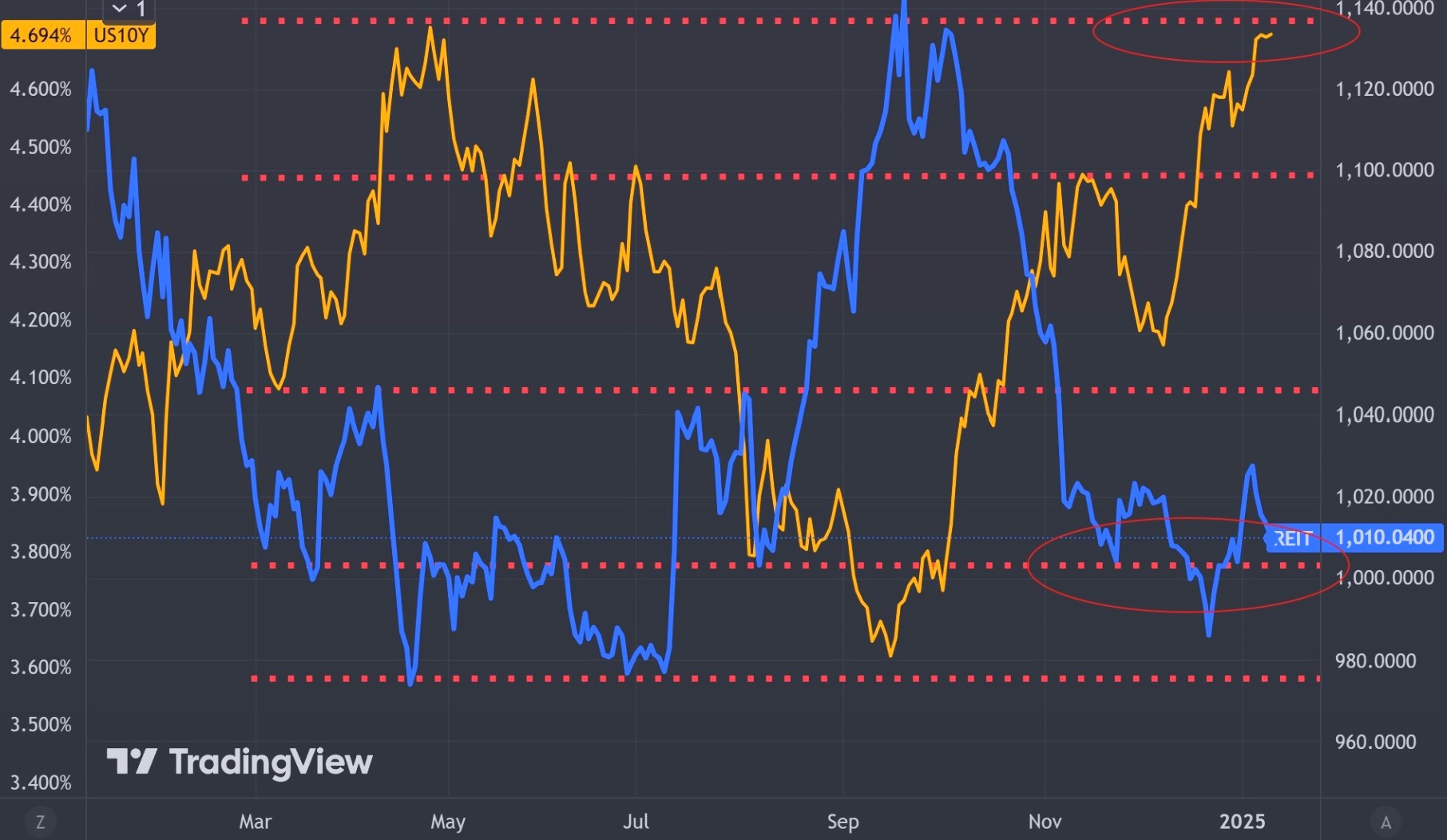iEdge S-Reit Index Weekly Review 10 Jan 25
Good Day Everyone!
Happy New Year and best wishes to you and your family! While 2024 was a challenging year, as we step into 2025, staying well-informed is key to navigating the markets and striving for success.
Current Sentiment
Recent economic data has highlighted the unexpected strength of the U.S. economy, resulting in the 10-year US Treasury yield climbing to around 4.69%, its highest level since April 2024. This reflects robust job vacancies and an expanding services sector, causing investors to reassess their expectations for Federal Reserve interest rate cuts.
The economy’s resilience has tempered the anticipated pace of rate reductions, driving bond yields higher and exerting pressure on yield-sensitive asset classes like REITs. Rising bond yields not only increase borrowing costs but also offer competitive returns, making SREITs less appealing to investors. This trend is clearly reflected in the chart below.

S-REITs Chart Analysis
The chart above illustrates the ongoing inverse correlation between the iEdge S-REIT Index (in blue) and the US 10-Year Treasury Bond Yield (in orange). As the US 10-Year Treasury Bond Yield climbs toward 4.7%, it faces a potential technical resistance level. Meanwhile, the iEdge S-REIT Index has plunged toward a lower support region.
Notably, around May 2024, when the US 10-Year Treasury Bond Yield reached similar levels, the iEdge S-REIT Index dipped below 1000. Recently, the index has already breached this level once, indicating that such occurrences may become more frequent if bond yields remain elevated. With the yield hovering near its current highs, it is crucial for investors to monitor whether this pattern persists, as it could indicate heightened volatility for SREITs in the near term.
Why Is This Happening?
The current pressures on Singapore Real Estate Investment Trusts (S-REITs) prices could be influenced by several factors:
Rising U.S. Government Bond Yields
As of January 2025, the 10-year U.S. Treasury yield has risen to approximately 4.69%, its highest level since April 2024. This increase has led to concerns about the distributions of S-REITs, prompting a sell-off as expectations of rate cuts diminish. Given the close correlation between Singapore and U.S. bond yields, Singapore’s yield curve is also expected to rise in the short term.
Uncertainty Surrounding Future U.S. Interest Rates
The U.S. Federal Reserve has signaled a gradual approach to lowering interest rates, indicating no urgency to ease monetary policy quickly. This uncertainty, coupled with the recent election of President-elect Donald Trump and his potential influence on economic and inflation outlooks, has increased volatility in the S-REIT sector.
Concerns About Inflation
Elevated inflation and interest rates, driven by the U.S. Federal Reserve’s rapid rate hikes from 2022 to 2023, have created a challenging environment for REITs. Market concerns about rising U.S. government debt from proposed tax cuts and a possible resurgence in inflation due to economic stimulation under the incoming Trump administration have also contributed to negative sentiment surrounding S-REITs.
Looking Ahead
With the 10-year U.S. Treasury yield remaining elevated and no significant changes in the economic outlook, S-REITs may continue to face challenges in the near term. High bond yields continue to pressure valuations, while uncertainty around interest rate cuts adds to the volatility.
Given these conditions, I am personally adjusting my focus within the S-REIT sector by reducing exposure to logistics-focused REITs, which may be more sensitive to economic cycles. Instead, I am prioritizing REITs with exposure to “all-weather” sources of income, such as malls that cater to essential daily needs. These assets may offer more stable returns, even in uncertain times.
As always, it’s important to stay informed and adaptable to evolving market conditions while focusing on quality and sustainability in investments.

Found this article useful? Share it and let us all have free coffee from dividends!